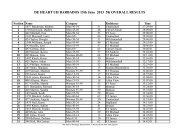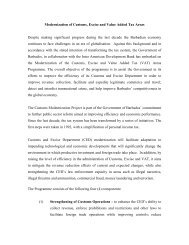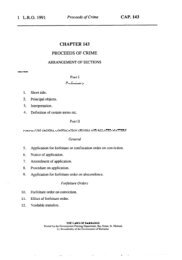The 2008 Agricultural Digest - Ministry of Agriculture and Rural ...
The 2008 Agricultural Digest - Ministry of Agriculture and Rural ...
The 2008 Agricultural Digest - Ministry of Agriculture and Rural ...
- No tags were found...
Create successful ePaper yourself
Turn your PDF publications into a flip-book with our unique Google optimized e-Paper software.
III. AGRICULTURE INDUSTRY IN BARBADOS<strong>Agriculture</strong> Industry Performance<strong>and</strong> the Barbados EconomyDownes (2001) highlighted that Barbados’ medium-term plansfor the periods 1952-1957 <strong>and</strong> 1955-1960, incorporated the initialsigns <strong>of</strong> the Government <strong>of</strong> the country’s intent on creating a morediversified economy, through the promotion <strong>of</strong> the manufacturing<strong>and</strong> tourism industries <strong>and</strong> a lesser reliance on the sugar industry.Downes (2001) also indicated that these national strategies wereconsistent with the approaches articulated by Lewis (1954)that mapped out the necessary strategic direction for regionaleconomic development.Using national accounts data, Howard (2006) investigatedthe changes in the compositional structure <strong>of</strong> the Barbadoseconomy throughout the years <strong>of</strong> 1955 to 2000. Patterns<strong>of</strong> structural change were identified by categorising thecountry’s economic industries into primary (agriculture <strong>and</strong>mining), secondary (manufacturing) <strong>and</strong> tertiary (services)industries, <strong>and</strong> analysing their respective contributions tonominal Gross Domestic Product (GDP) over the review period.From his examination <strong>of</strong> the movement <strong>of</strong> the broadly definedindustries, Howard (2006) concluded that over the past fivedecades the Barbados economy observed a persistent shiftaway from primary production <strong>and</strong> has become moreservices-oriented.While Howard’s (2006) analysis may be criticised for his use <strong>of</strong>nominal GDP <strong>and</strong> proportional statistics to observe the transition<strong>of</strong> the Barbados economy over the past five decades, the dearth<strong>of</strong> real GDP statistics for Barbados from as far back as the 1950snecessitates this approach. Howard’s (2006) examination also allowsus the opportunity to take a wider glance at the economicstructure <strong>of</strong> the Barbados economy.Table 1 presents an adaptation <strong>of</strong> the industrial distribution<strong>of</strong> GDP for Barbados from Howard’s (2006) analysis, with theinclusion <strong>of</strong> 2007 data that was garnered from the BarbadosEconomic <strong>and</strong> Social Report 2007. An examination <strong>of</strong> thedata shows that over the past fifty years, the contribution<strong>of</strong> the agriculture industry to GDP has continued on a downwardtrajectory. During 2007, the agriculture industry wasestimated to have contributed approximately 2.9 percent<strong>of</strong> the country’s nominal GDP. This represents a significantdecline from the 35.2 percent the industry had contributedto GDP during 1955. On the other h<strong>and</strong>, the contribution<strong>of</strong> the services industry to GDP over the comparative periodhad doubled from 45 percent in 1955 to 90.2 percent in 2007.In addition, over the review period, the manufacturing orsecondary industry also displayed a steady decline from the19.8 percent which it contributed to GDP during 1955, to acontribution <strong>of</strong> 6.2 percent during 2007. This decline in theperformance <strong>of</strong> the manufacturing industry may support Timmer’s(1998) argument that the manufacturing industry is usuallydependent on improvements in the agriculture industry. <strong>The</strong>refore,countries that have a stagnant agriculture industry <strong>of</strong>ten showno industrial development.Craigwell et al (<strong>2008</strong>) also investigated the inter-relationships amongthe agriculture, industry <strong>and</strong> services industries in Barbados overtwo distinct time periods over the past five decades (1946-1969<strong>and</strong> 1970 to 2003). <strong>The</strong> aim <strong>of</strong> the study was to shed some lighton whether changes in the output in one industry impacted on theothers. <strong>The</strong> authors suggested that the results <strong>of</strong> the analysis couldbe used by policy makers to better underst<strong>and</strong> the sectors thatprincipally drive economic growth in Barbados.Volume 1<strong>Agricultural</strong> <strong>Digest</strong> | <strong>2008</strong>7
















